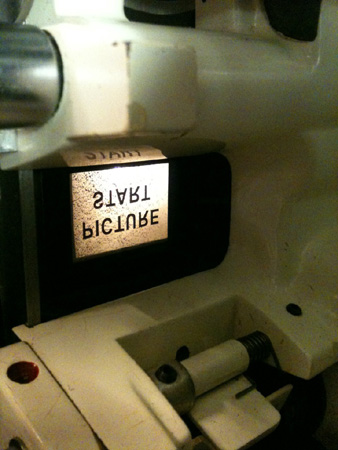"Symbiosis" Cast & Credits |
Read more at in70mm.com The 70mm Newsletter |
| Created by: Paul Gerber, gerberfilm.com & Thomas Hauerslev | Date: 15.09.2012 |
 Paul
Gerber in his home in California 2012 Paul
Gerber in his home in California 2012Original title: Symbiosis. Working (tentative) title: Symbiosis. Filmed in: 65mm, 5 perforations, 30 frames per second. Principal cinematography filmed in: Super Panavision 70. Presentation format: 70mm and 13 (thirteen) track stereo (double system). Aspect ratio: 2,56:1. Country of origin: USA. Year of production: 1980-1982. Released by: Walt Disney. World Premiere cinema: Harvest Theatre, EPCOT Center (Florida, USA), Land Pavilion, October 2, 1982. Producer: Paul Gerber. Director: Paul Gerber. Screenplay: Paul Gerber. Director of photography: Eric Saarinen. Film editor: Gordon D. Brenner. Music: Patrick Gleeson. Sound recorder: Dickie Rector. Narrator: Phil Clarke. Production company: Walt Disney. Executive producer: Randy Bright. Line producer: Sascha Schneider. Associate producers: Lin George (now Wolff), Eileen Moskowitz. Sponsor: Kraft Food. Concept and scenario: Paul Gerber. Concept consultant: Carl Hodges *). Original treatment: Paul Gerber. Camera assistant: Kit Kalionzes. Camera operator: Eric Saarinen. Aerial photography: Rod Goodman (now with Spacecam). Assistant DP: Kit Kalionzes. Boom operator: Kit Kalionzes. First assistant: Kit Kalionzes. Aerial mount: Wescam. Helicopter pilot: Marc Wolff. Airial coordinator: Marc Wolff. Gaffer & Key grip: Various people and local crews. Music conductor: Patrick Gleeson. Piano: George Winston. Sound mixer: Richard Portman. Sound mixing stage: Walt Disney. Sound design: Sean Murphy. Film stock: Eastman Kodak 65mm. Shooting ratio: 40:1. 65mm negative developing & processing: Technicolor. Color by: Technicolor. Number of 70mm prints: Less than 10. Number of 35mm prints: 1. Recorded in: Dolby Running Time (70mm): 18:25. |
More in 70mm reading: "Norway" Cast & Credits Motion pictures photographed in Super Panavision 70 & Panavision System 65 Internet link: EPCOT Land Pavilion Lost EPCOT |
 DP70
machine ready to run 70mm film. Image by Orla Nielsen DP70
machine ready to run 70mm film. Image by Orla NielsenVarious notes: ”Symbiosis” was seen by 28 million people during its 11 years and 4 months run at the 428 seat Land Pavilion at EPCOT Center. ”Symbiosis” was the first film to be mixed digitally at Walt Disney. Production team scouted locations in 22 countries. Locations in 18 countries appears in the film (Canada, Egypt, France, Germany, Hong Kong, Israel, Italy, Kenya, Norway, Peru, Philippines, Sweden, Switzerland, Tahiti and United States). ”Symbiosis” took 43 weeks to film. The filming crew was usually 8 people or less. 2 hand held Panavision 65mm were used during filming. “Symbiosis” ended its long run in the Land Pavilion’s Harvest Theater in January 1995, when the pavilion changed sponsors. The theater’s next film, “The Circle of Life”, which premiered on January 21, 1995, was also focused on the environment and made use of footage originally shot for “Symbiosis”, but it took an entertainment-style approach to the subject, using the characters Timon, Pumbaa, and Simba from the 1994 Disney animated feature film “The Lion King” to tell its story. ”Symbiosis” was shown at the Widescreen Weekend in Bradford, England in 1998 and at 8th Todd-AO Festival at the Schauburg October 5-7, 2012 in Karlsruhe, Germany. *) Carl Hodges led the Land Pavilion’s scientific advisory board and was the founding director of the University of Arizona's Environmental Research Lab. On the 30 fps, as I recall it, that was a DP driven decision. Heightened resolution. |
|
|
Synopsis: A sweeping look at the history of man’s
relationship with the environment around the planet, from the very primitive
to the distinctly exotic to the technologically inventive to the
thoughtlessly destructive, examining both the short-sighted failures that
have led to grave consequences and the visionary hopes that drive a search
for greater wisdom and balance. |
|
Reviewed by Marc Mancini in “Film Comment” | |
|
The most eloquent wide-screen motion picture at Epcot is
“Symbiosis”. It had to be. Thrown by only one conventional 70mm projector
and unpropped by technological claptrap, the film powerfully presents the
delicate balance between scientific progress and environmental integrity.
Says director Paul Gerber: “I wanted a contemplative, majestic experience, with moments of quiet beauty but also with moments of violent action.” “Symbiosis” is at times too self-conscious in its visual and dialectic perspectives, but Gerber shows his dexterity with well-composed images, even-handed exposition, metaphorical editing and a daredevil’s love for heady aerial motion. A large screen and 30-frames-per-second projection enhance Gerber’s essay on man’s equivocal relationship with nature, but the film’s most breathtaking moment would probably work on a TV screen. Beginning with a calm closeup of an Indian on horseback, the camera draws back across a lake, past ripples, rocks, bushes, gains frantic velocity—and suddenly drops over the top of a towering concrete dam. The visual contrast between nature and technological momentum in this one take could hardly be more forceful. |
|
Reviewed by Greg Tozian, “On Location Magazine” | |
|
The Land—Filmmaker Paul Gerber has created a
scrumptious-looking movie that fits perfectly into the environmentally
knowing Land pavilion, with screening in the 550-seat Harvest theater.
Gerber’s 17-minute-plus film, “Symbiosis”, is a classic affirmation that
effective film can be made by someone with equal devotion to science and
art. It explores the mutually dependent relationship between man and nature;
and it doesn’t disregard man’s frequent rape of and injustices toward the
natural world we live in. Full advantage is taken of an educational
narrator, and the layered, live sound recording uses the 13-track speaker
system to wonderful effect. Herein lies some of EPCOT Center’s most
beautiful footage—as lovely as anything in Hollywood’s most painterly films.
These memorable images were captured in a staggering 53-week shooting
schedule, in more than 20 countries, including France, Germany Switzerland,
Peru, Tahiti and Kenya. Eric Saarinen was director of photography. |
|
| Go: back - top - back issues - news index Updated 22-01-25 |
